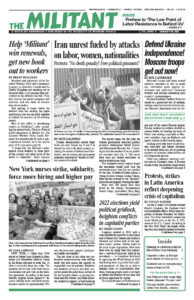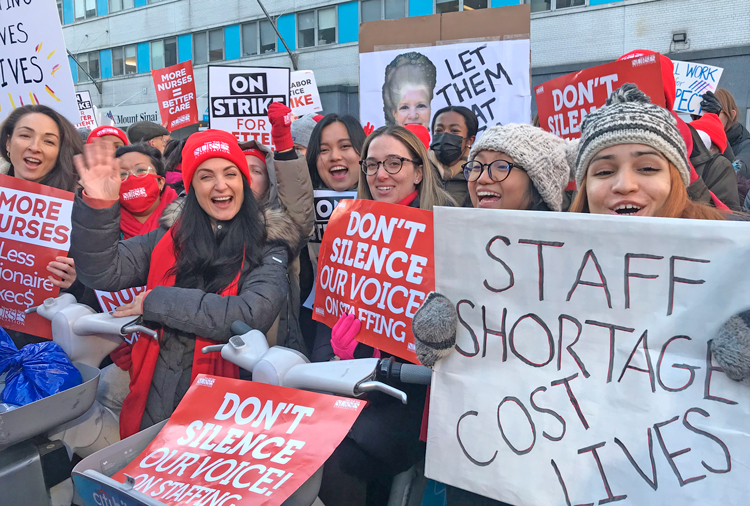NEW YORK — More than 7,000 nurses at Mount Sinai Hospital in Manhattan and Montefiore Medical Center in the Bronx returned to work Jan. 12 after a successful three-day strike. The members of the New York State Nurses Association will now vote on the tentative agreement. According to the union website, hospital bosses agreed to “increase staffing levels and enforcement, increase salaries by approximately 19% over the three-year contract, [and] protect health-care benefits.”
The key issue in the strike was enforceable patient-to-nurse ratio staffing levels that give nurses the capacity to responsibly care for patients. Hundreds and hundreds of nurses and their supporters joined the picket lines in front of the two hospital centers, as passing bus, truck and taxi drivers, and other motorists, honked in support. A band made up of union members played in the crowd.
The strike came on top of threatened actions during the previous week by thousands more nurses at six additional medical centers who were able to secure new contracts boosting staffing and pay. That included 4,000 nurses at New York-Presbyterian hospitals.
Twelve hundred nurses at four more hospitals — Interfaith and Kingsbrook Jewish medical centers, the Brooklyn hospital center and Wyckoff Heights — have threatened to strike as well.
“It’s not about the money,” Lisette Kimbere, an oncological nurse practitioner and a member of the contract action team, told this Militant worker-correspondent on the picket line. “If we get paid better, but the conditions don’t improve, we won’t stay. That’s the problem.”
“I’m happy we went on strike,” Sonia David, an intensive care unit nurse who has worked at Mount Sinai Hospital for more than 16 years, said after two days back on the job. “Conditions and pay are so bad that new nurses don’t stay. When we negotiated the last contract the hospital promised more nurses per patient, but it never happened. It just got worse.
“One day they’re short housekeeping staff. So they tell you to clean the room and make up the bed. You do it once, because there’s a sick person who needs the bed,” she said. “Next thing you know, the hospital expects you to do it all the time.
“We would meet with the managers and they would say, ‘Yes, yes,’ but nothing changed,” David said. “That’s why the strike was so important.
“We’re the lowest-paid nurses of the major hospitals in the city, including others that are part of the Mount Sinai Health System,” she added. “Even the nurses at other hospitals owned by Mount Sinai make more. The workers had been asking for equal pay. We won the same raise, but that didn’t close the gap.
“I used to assume that hospitals were ‘not-for-profit,’ but now I realize it’s all a business to them,” she said.
“The strike was definitely worth it,” said Kathryn, another ICU nurse, who asked that her last name not be used because she’s only been working for a couple of months. “They say they’re establishing 170 new positions. But there’s already hundreds of existing positions that haven’t been filled. It was a good feeling being out together.”
This strike battle was one of dozens of strikes and protests by nurses and other workers — including rail workers across the country last fall — over onerous staffing shortages and schedules, as well as wages that don’t keep pace with soaring prices.
Two days after the strike ended, the New York State Nurses Association announced the 800 nurses at Mount Sinai South Nassau voted to join the union. This Oceanside hospital on Long Island was the last nonunion facility in the Mount Sinai Health System.


